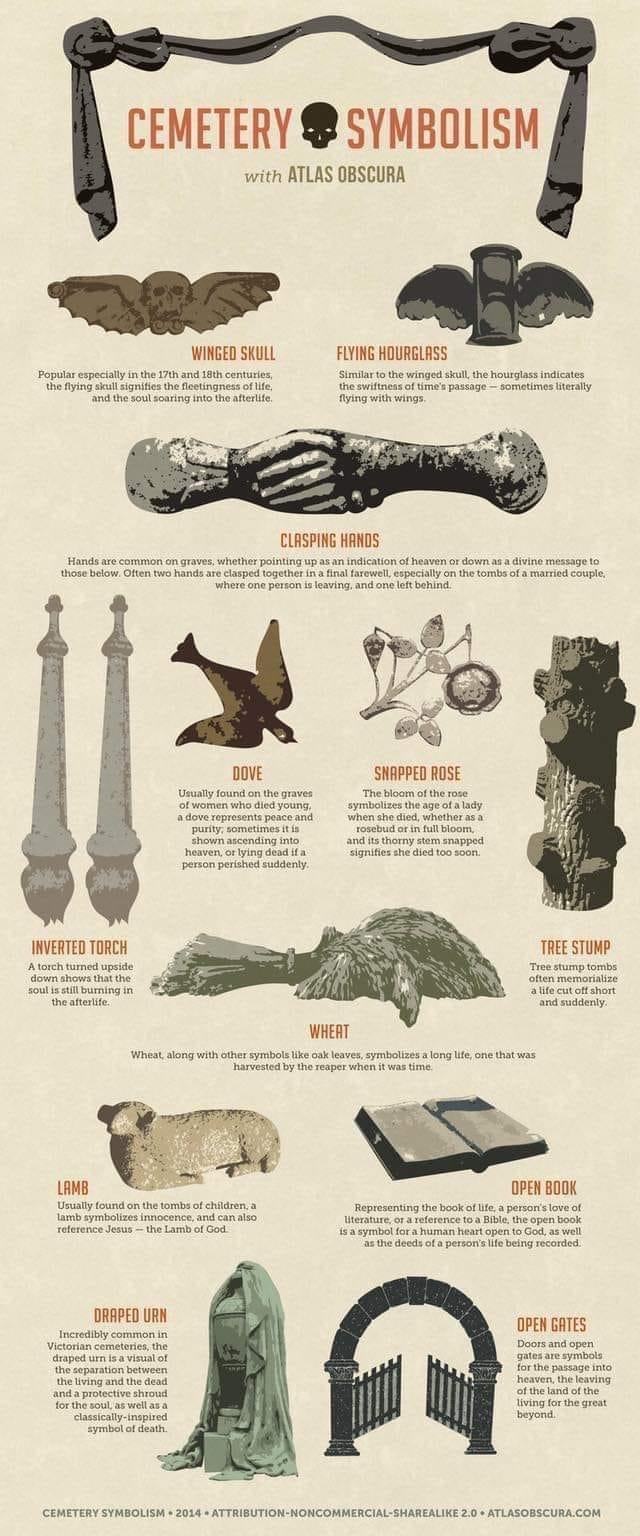
If you’ve ever visited a cemetery, you’ve probably noticed the symbolism that’s often found on tombstones. From angels to crosses to rosettes and more, these symbols are meant to comfort the living as well as honor the dead. Here are some of my favorite symbols:
A winged skull is a symbol for death. The skull is often depicted with wings and a halo, or as a skeleton or corpse, holding an hourglass in its hand. A flying hourglass represents the sands of time. The hourglass is an ancient symbol of time. It represents the passage of time, and it has come to represent mortality as well. The image of an hourglass reminds us that life is short–and even if you live for a long time, you can’t cheat death; it will catch up with everyone eventually. The flying hourglass has been used as a symbol for death since at least the 16th century, when artists like Albrecht Durer depicted them in their work (he did so because he wanted his viewers to think about their own mortality). Today this image is still popular among those who want their loved ones’ final resting places to look beautiful while also being meaningful: You’ll see flying hourglasses on headstones all over cemeteries across America! Clasping hands signify union in the afterlife. The clasped hands are often seen to represent a couple’s commitment to each other, as well as their pledge to be united for eternity. This symbol can also be used on headstones and memorials of those who have passed away, showing that they are still together even though they’re no longer physically here on Earth with us. Doves are a symbol of peace, hope and the Holy Spirit. The dove is also associated with the Virgin Mary (the mother of Jesus Christ) as well as being a symbol of the Resurrection. The dove was used in many cultures throughout history to represent these things because it’s an animal that has no fear–it flies wherever it wants without worry about predators or anything else getting in its way. This makes them seem fearless and free-spirited; someone who has this kind of attitude might also be considered peaceful or hopeful.
Snapped roses signify that life has ended prematurely and without beauty or grace. Snapped roses are often used to represent the end of a life. They symbolize that life has ended prematurely and without beauty or grace, which can be interpreted as an unfortunate circumstance. An inverted torch symbolizes darkness and despair in the cemetery. The torch is a symbol of enlightenment and knowledge, so it makes sense that an inverted one would represent the opposite: ignorance, or lack of understanding. This is often used to represent the end of life; when someone dies, they lose their ability to think clearly about anything but death itself–and even then only for so long before they’re gone forever. A tree stump signifies new beginnings after death, or being cut off from life before its natural end. A tree stump is often used as a grave marker, and it represents the idea that life is like a tree. The roots are deep in the ground, where they soak up nutrients from nature and anchor the trunk to earth; then there’s the trunk itself which provides support for branches and leaves above ground level; finally there are those branches–they may be bare at times but always have some green buds waiting for springtime when they’ll blossom into new growth again. This cycle continues year after year until one day someone comes along with an axe and cuts down this majestic creature that has been growing for generations…but not without leaving behind an eternal reminder of how fleeting we all are: A dead tree stump!
Wheat is used as a reminder that we will ultimately be buried in the ground, but our lives will continue on in our descendants’ lives. This symbolizes that death is not an end to life–it’s only a transition into new beginnings. Wheat also stands for resurrection and new life because it grows quickly and easily out of the ground after being planted there once before. Lambs are often depicted with bent heads and folded wings; they represent innocence, purity and vulnerability, especially in their willingness to be sacrificed for their sins by their parents through God’s command that Abraham sacrifice Isaac at Mount Moriah (Genesis 22). In Christian culture, lambs symbolize Christ who was “the Lamb of God…who takes away the sin of the world.” The Passover lamb was an annual ritual sacrifice commemorating Israel’s deliverance from Egypt as told in Exodus 12:1-28. It was part of the Feast of Unleavened Bread which began on 15th Nisan and lasted for seven days until 21st Nisan. During this time no leaven could be eaten or possessed in any form within your house; it had to be removed from before sunset on 14th Nisan until after dark on 21st Nisan inclusive; otherwise all your firstborn males would die (Exodus 12:15-20).
We hope this article has helped you understand the symbolism used in cemeteries.
